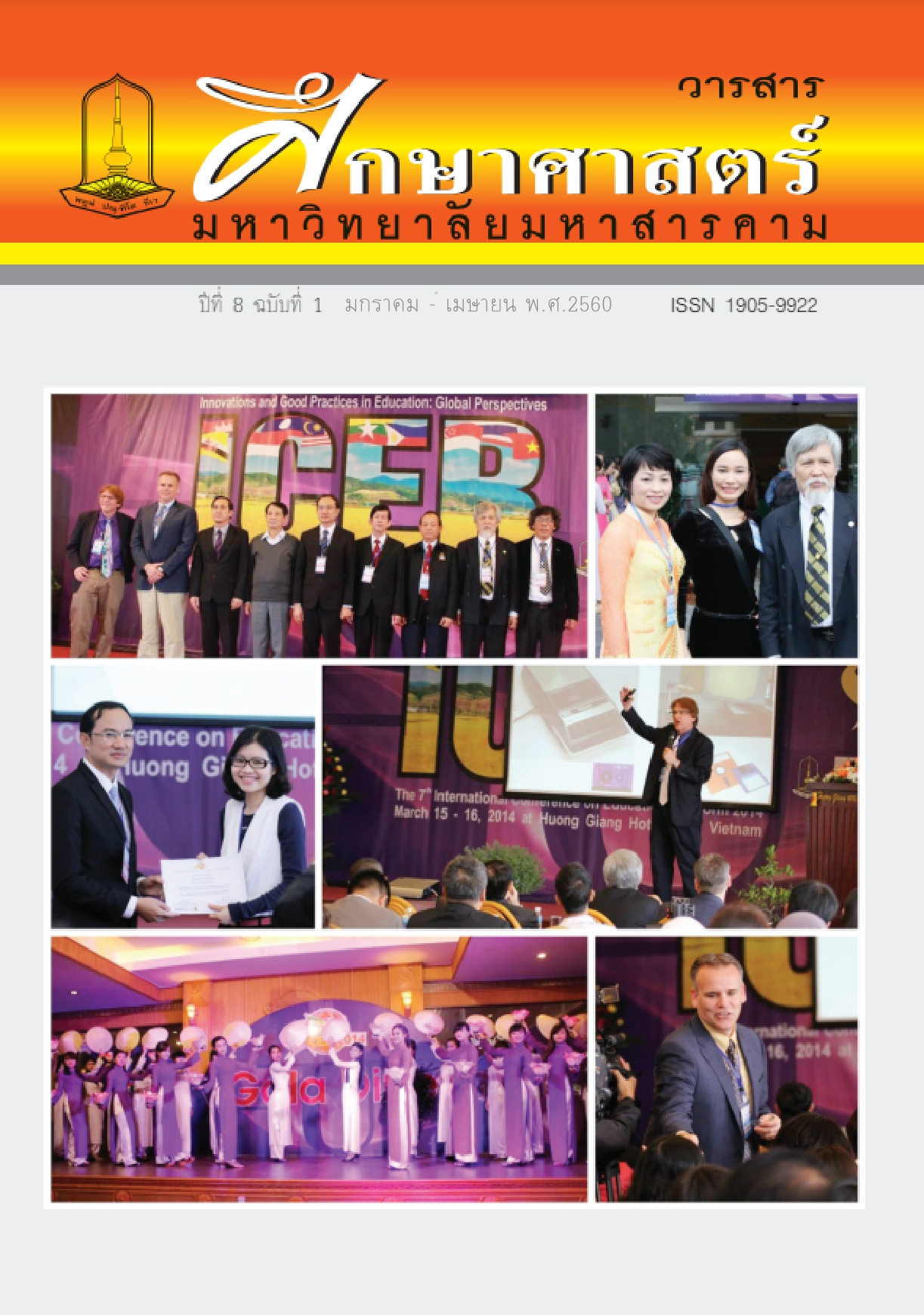The Development of the Experience Enhanced-Activities According to Reggio Emilia Practice in order to Encourage Assertiveness Behavior and Listening and Speaking Skills of Early Childhood Children
Main Article Content
Abstract
The purposes of this study were: 1) to develop experience enhanced-activities based on the Reggio Emilia practice in order to encourage assertiveness behavior and listening and speaking skills of early childhood children and aimed to meet the value of effectiveness of 80/80 criterion 2) to examine the listening and speaking skills of early childhood children before, while, and after learning based on the Reggio Emilia practice 3) to study the assertiveness behavior of early childhood children before, while, and after learning by the Reggio Emilia practice. The purposive sampling technique was employed and the samples were 20 three-year-old childhood children studying in the first semester of academic year 2016 at Ban Phonsawan child development center, Kud sim Kummai municipality, Khao Wong district, Kalasin province. The research instruments were: 1) lesson plans based on the Reggio Emilia practice with 4 units; 20 lesson plans 2) 2 language skills evaluation forms dividing into listening skills evaluation form with 10 items and speaking skills evaluation form with 10 items 3) evaluation form of assertiveness behavior of early childhood children. The statistics used were Percentage, Mean, and Standard deviation.
The findings were as the following
1) The effectiveness value of lesson plans based on the Reggio Emilia practice aiming to encourage assertiveness behavior and listening and speaking skills of early childhood children was 84.06/87.57, which higher than the prospective 80/80 criterion. 2) The listening and speaking skills of early childhood children after learning by the Reggio Emilia practice were improved. The children had attention towards the story the people were talking about. They did not talk and they respected the speakers. They could perform according to the orders. All these behaviors make the assessment score after learning by the Reggio Emilia practice higher than that before and while learning with the average score of 8.75 out of 10; accounting for 87.50 per cent. In the same way, the speaking skill was improved as well. The early childhood children could answer correctly by themselves. They could tell the stories confidently and present their own works with loud voice. The assessment score was 8.60 out of 10; accounting for 86.00 per cent which higher than that before and while learning. 3) The assertiveness behavior of early childhood children after learning by the Reggio Emilia practice. The assertiveness score was 13.30 out of 15; accounting for 88.67 per cent. The highest assertiveness belonged to the area of working. Early childhood children could work with their full capacity. They were industrious enough to get the works done and reach the goals. They, without any worries, dared to refuse when people asked them to do something that they could not do. The lowest assertiveness score belonged to the area of accepting critiques from other people. They did not responsible for their faults and delivered opinions or comments to others with anxiety.
Downloads
Article Details
References
กาญจนา ซ่องผม. (2555). ผลการจัดประสบการณ์เพื่อส่งเสริมพัฒนาการด้านสติปัญญา ความสามารถในการแก้ปัญหาและความฉลาดทางอารมณ์ของเด็กปฐมวัย ระหว่างการใช้แนวคิดเรกจิโอ เอมีเลียและแนวคิดจอห์น ดิวอี้. วิทยานิพนธ์ กศ.ม. มหาสารคาม: มหาวิทยาลัยมหาสารคาม,
กิรณา เกี่ยสกุล. (2552). คำพ่อสอนกับการศึกษาปฐมวัย. กรุงเทพฯ: โรงพิมพ์คุรุสภาลาดพร้าว.
กุลยา ตันติผลาชีวะ. (2545). การเลี้ยงดูเด็กก่อนวัยเรียน ; 3 – 5 ขวบ. กรุงเทพฯ: เอดิสัน เพรสโปรดักส์.
กุลยา ตันติผลาชีวะ. (2551). รูปแบบการเรียนการสอนปฐมวัยศึกษา. กรุงเทพฯ: แบรน เบส บุ๊ค.
ตรรกพร สุขเกษม. (2554). การพัฒนาพฤติกรรมกล้าแสดงออก โดยใช้วิธีการแสดงบทบาทสมมติของนักศึกษาระดับชั้นปีที่ 1 ภาคเรียนที่ 2/2554 ในบทเรียนเรื่อง “การกำหนดนโยบายสาธารณะ.” แพงเพชร: มหาวิทยาลัยราชภัฏกำ แพงเพชร.
ประเทือง สุภาสอน. (2550). ผลการจัดประสบการณ์ตามแนวการสอนภาษาแบบธรรมชาติที่มีต่อความสามารถทางภาษาและความเชื่อมั่นในตนเองของนักเรียน. วิทยานิพนธ์ กศ.ม. สกลนคร: มหาวิทยาลัยราชภัฏสกลนคร.
ปิยะพร กงไกร. (2544). วิจัยในชั้นเรียนเรื่อง การพัฒนาพฤติกรรมกล้าแสดงออกโดยวิธีการแสดงบทบาทสมมติของนักเรียนระดับชั้น ปวช. 3/1 สาขาวิชาการขาย ในรายวิชาการจัดจำหน่ายสินค้าและบริการ. ขอนแก่น: วิทยาลัยการอาชีพขอนแก่น.
ภรณี คุรุรัตนะและคณะ. (2542). การเรียนรู้ของเด็กปฐมวัย (3 – 5 ปี): แนวคิดของกลุ่มนักศึกษา. กรุงเทพฯ: เซเวนพริ้นติ้งกรุ๊ป.
วลิญา ปรีชากุล. (2550). การใช้กิจกรรมศิลปะวาดภาพเพื่อสร้างเสริมความคิดสร้างสรรค์ของนักเรียนอนุบาล. วิทยานิพนธ์ ศษ.ม. เชียงใหม่: มหาวิทยาลัยเชียงใหม่.
ศศิธร เวียงวะลัย. (2556). การจัดการเรียนรู้ (Leaning Management). กรุงเทพมหานคร: สำนักพิมพ์โอเดียนสโตร์.
สำนักงานรับรองมาตรฐานและประเมินคุณภาพการศึกษา. (2558). รายงานผลการประเมินคุณภาพการศึกษาประจำปีการศึกษา 2558, กาฬสินธุ์: สำนักงานรับรองมาตรฐานและประเมินคุณภาพการศึกษา จังหวัดกาฬสินธุ์.
สุจิตตรา สุดชารี. (2554). การพัฒนาความคิดสร้างสรรค์ชั้นอนุบาลปีที่ 2 โดยใช้กิจกรรมศิลปะตามแนวคิดเรกจิโอ เอมีเลีย. การศึกษาค้นคว้าอิสระ กศ.ม. มหาสารคาม: มหาวิทยาลัยมหาสารคาม.
อัจฉริยะ ควรทิพย์. (2557). ฟังหนูหน่อย. กรุงเทพฯ: บริษัทพิมพ์ดีการพิมพ์จำกัด.


